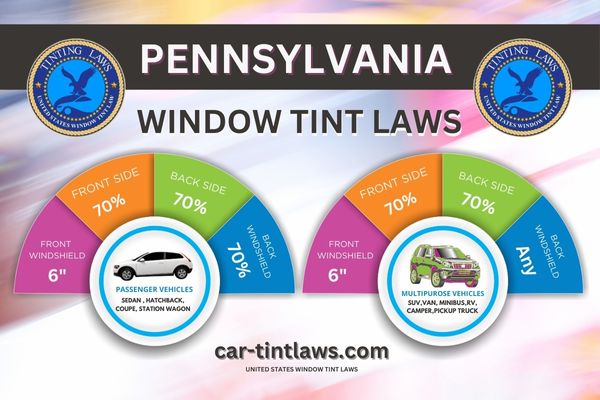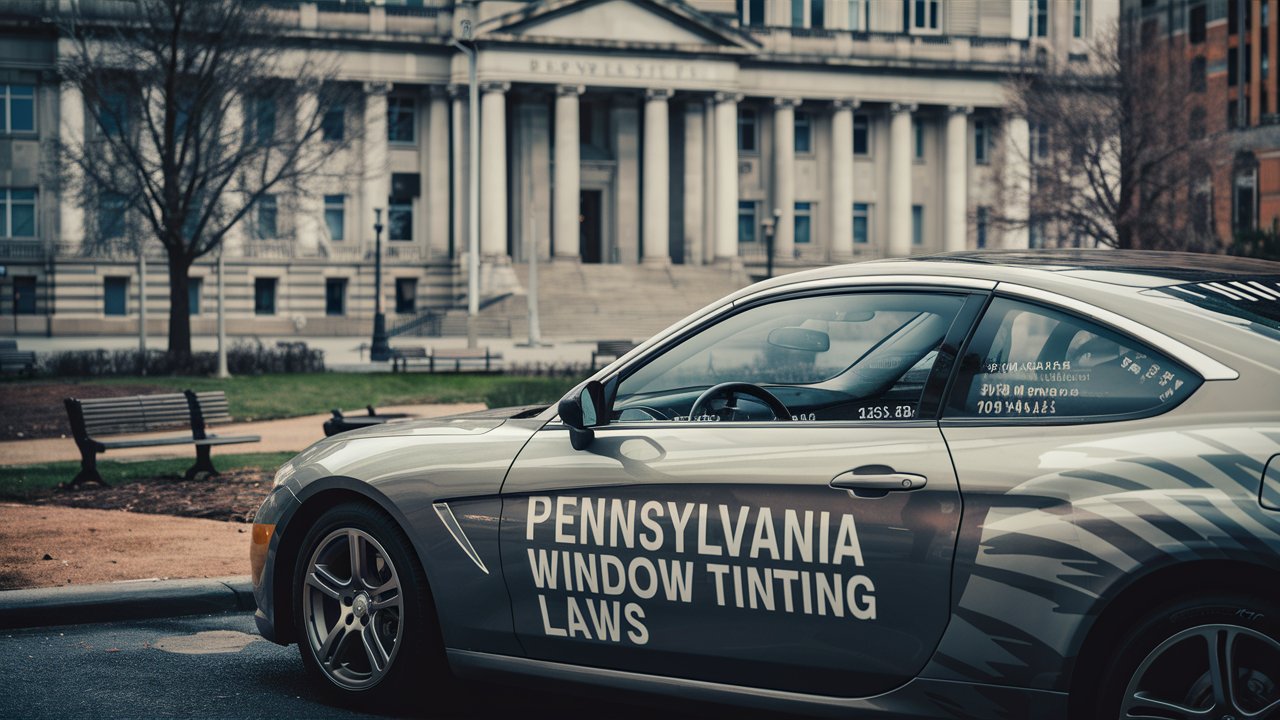Think of your car’s windows as the eyes of your vehicle, revealing just enough to keep you safe while maintaining a bit of privacy.
Pennsylvania’s window tinting laws are designed to strike that balance, dictating specific levels of light transmission for sedans, SUVs, and vans. But, did you know that the rules for front and back side windows are different?
And if you’re considering a mirrored tint, you might want to think again. Understanding these regulations can save you from fines and guarantee your vehicle’s compliance.
So, how does your car measure up to Pennsylvania’s standards?
Window Tint Darkness in Pennsylvania
When discussing window tint darkness in Pennsylvania, you’ll need to know that sedans must have front side, rear side, and rear windows with over 70% light transmission to comply with the law.
Similarly, SUVs and vans require their front side, rear side, and rear windows to allow over 70% of light through.
If your back windshield is tinted at 70% VLT, dual side mirrors are mandatory to meet the state’s regulations.
Tint darkness for sedans:
- Windshield: Non-reflective tint is allowed on the top 6 inches of the windshield.
- Front Side windows: Must allow more than 70% of light in.
- Back Side windows: Must allow more than 70% of light in.
- Rear Window: Must allow more than 70% of light in.
Tint darkness for SUV and Vans:
- Windshield: Non-reflective tint is allowed on the top 6 inches of the windshield.
- Front Side windows: Must allow more than 70% of light in.
- Back Side windows: Must allow more than 70% of light in.
- Rear window: Any shade can be used
Window Tint Reflection in Pennsylvania
When it comes to window tint reflection in Pennsylvania, it’s essential to understand the specific regulations for different types of vehicles.
For sedans, as well as SUVs and vans, the law prohibits any mirrored or metallic tint on the front and rear side windows.
This means your window tint can reflect light to reduce heat and glare, but it must not have a reflective finish, ensuring compliance with safety and visibility standards.
Tint reflection for sedans:
- Front Side windows: Must not be mirrored or metallic tinted.
- Rear Side windows: Must not have mirrored or metallic tint.
Tint reflection for SUV and vans:
- Front Side windows: Must not be mirrored or metallic.
- Back Side windows: Must not be mirrored or metallic.
Other Pennsylvania window tint rules and regulations
- Side Mirrors: No restrictions.
- Restricted Colors: In Pennsylvania, all tint colors are permitted.
- Certificates: Manufacturers of film need to certify the film they sell in the state. Ask your dealer if they are using certified film.
- Stickers: The sticker/label of compliance to identify legal tinting is required between the film & glass on each tinted window.
- Medical Exceptions: Pennsylvania permits medical exemptions for special tint. For more details about the specific terms of the exemption, consult PA state law.
- Penalties: Violating tinting laws in Pennsylvania can result in fines that vary based on the severity of the infraction.

Medical Exemptions for Window Tint Rules in Pennsylvania
Individuals with specific medical conditions can obtain a medical exemption for window tint rules in Pennsylvania by providing the necessary documentation from a healthcare professional.
These medical exemptions allow for the use of colorless products that filter UV rays, catering to individuals with conditions that require such protection.
To qualify, you’ll need certification from a physician or optometrist who attests to the medical necessity of the special tinting.
The Medical Advisory Board in Pennsylvania is responsible for certifying exceptions to the window tint regulations based on these medical needs.
If you think you qualify, the first step is to contact PennDOT’s Medical Unit at (717) 787-9662.
They will guide you through the process and inform you of the specific documentation required.
The application process involves submitting a detailed certification from your healthcare provider, which outlines your medical condition and the need for UV protection.
This documentation must be thorough and convincing to meet the standards set by the Medical Advisory Board.
Once approved, you’ll be granted permission to use the necessary tinting, ensuring you’re protected while complying with state regulations.
Remember, this exemption is a privilege for those with legitimate medical needs, so accurate and honest documentation is vital.
Pennsylvania Window Tint Ticket Cost
In Pennsylvania, receiving a window tint ticket can cost you up to $110 if your vehicle’s tint doesn’t meet state regulations.
The enforcement of these tint laws is taken seriously, and police have the authority to stop vehicles with illegal window tint.
To dodge these fines, it’s crucial to guarantee compliance with Pennsylvania’s window tint regulations.
Verification of the Visible Light Transmission (VLT) percentage may be necessary by PennDOT or a certified tint shop to determine if your tint is legal.
Non-compliance with these tint laws can lead to more than just fines; there can be broader legal consequences.
It’s important to be aware that any window tint outside the legal limits can result in penalties.
Understanding and adhering to these regulations not only helps you avoid fines but also ensures you’re within the legal framework set by the state.
If you’re unsure about the legality of your window tint, seek verification from a professional to guarantee you’re in compliance and avoid the hefty window tint ticket cost.
To sum up, staying informed about Pennsylvania’s tint regulations is vital to avoiding fines and maintaining legal compliance.
Pennsylvania Climate and Geography
Pennsylvania’s climate, with its hot summers and cold winters, impacts your need for window tinting, providing benefits like UV protection and temperature control.
The state’s diverse geography, from urban hubs like Philadelphia and Pittsburgh to rural areas, influences preferences for window tinting based on privacy and sun exposure.
Whether you’re dealing with increased traffic in cities or enjoying outdoor activities in the scenic countryside, window tinting offers comfort and safety advantages tailored to your environment.
Seasonal Weather Effects
Experiencing four different seasons, Pennsylvania’s climate and varied geography significantly impact driving conditions and the effectiveness of window tinting.
As a vehicle owner, you’ll observe how seasonal weather can influence your driving experience and the comfort inside your car.
During the hot summers, window tint helps reduce sunlight exposure and regulates heat levels, making your vehicle more comfortable.
In the colder months, window tint can also play a role in maintaining a stable internal temperature by providing an additional layer of insulation.
The state’s diverse geography, which includes mountains, forests, and urban areas, further affects how window tint films perform.
In urban settings, tints can offer privacy and reduce glare, while in wooded or mountainous regions, they help manage the light intensity that filters through dense foliage.
Pennsylvania’s climate, characterized by snowy winters and sunny summers, necessitates durable and high-quality tint films that can withstand these conditions without deteriorating.
Understanding how Pennsylvania’s seasonal weather patterns and diverse geography affect your vehicle’s environment is essential.
It allows you to choose the right window tint, ensuring the best comfort, protection, and durability throughout the year.
So, keep these factors in mind when selecting your window tint to enhance your driving experience.
Geographic Tint Preferences
Understanding the geographic tint preferences in Pennsylvania requires considering the state’s diverse climate and varied terrain.
In urban areas like Philadelphia, you’ll notice more vehicles with tinted windows.
This is primarily to reduce the glare from city lights and buildings, making driving at night safer and more comfortable.
The light tinting also helps in maintaining visibility during the day, conforming to state laws on permissible window tint levels.
On the other side, rural regions in Pennsylvania often prioritize window tinting for heat reduction during the hot summer months.
The benefits of window tinting here include not just keeping the interior cooler but also improving fuel efficiency by reducing the need for air conditioning.
Additionally, the state’s mountainous terrain means higher altitudes where UV protection becomes vital, influencing choices in window tinting.
Drivers across Pennsylvania also consider the changing seasons when selecting tints.
A good quality tint can offer both UV protection and insulation against cold temperatures, enhancing comfort year-round.
By understanding these geographic tint preferences, you can better appreciate how residents adapt their window tinting choices to their immediate environment, making the most of the benefits offered by tinted windows.
UV Protection Necessity
Given the state’s varying weather conditions and high UV index levels, UV protection through window tinting is vital for Pennsylvania residents.
This protection is important because UV rays can cause significant skin damage and contribute to eye strain, especially with prolonged exposure to the sun.
Window tinting with UV-blocking properties helps mitigate these risks, making your time inside the vehicle safer and more comfortable.
Moreover, UV protection isn’t just about your health; it also extends to your car’s interior.
The UV-blocking properties in window tinting help prevent fading and damage to upholstery and dashboard materials, ensuring that your vehicle’s interior stays in good condition for longer.
This protection is particularly significant for Pennsylvania residents who spend a significant amount of time in their cars, whether commuting or traveling.
Additionally, window tinting enhances comfort and safety for drivers and passengers.
By reducing glare and heat from the sun, it makes driving less strenuous and more pleasant, especially on bright, sunny days.
Given Pennsylvania’s high UV index levels, investing in window tinting with UV protection is a practical and necessary measure for maintaining both your well-being and the longevity of your vehicle’s interior.
References
Pennsylvania Department of Transportation: Vehicle Window Tint Fact Sheet (.pdf file)
Pennsylvania Code Title 75 – VEHICLES, § 4524
PA Code Chapter 175 Title 67: § 175.67. Glazing
Frequently Asked Questions
What Is the Darkest Legal Tint in Pennsylvania?
You’re wondering about the darkest legal tint in Pennsylvania. It’s 70% VLT for front and backside windows.
Tint regulations are strict, so knowing tint visibility, enforcement, fines, exemptions, installation, safety, benefits, alternatives, and maintenance matters.
Is 35% Tint Legal in Pa?
No, 35% tint isn’t legal in PA. The law mandates over 70% VLT for front side windows.
This guarantees visibility concerns are addressed, aiding law enforcement and safety regulations. Non-compliance can result in fines and penalties.
Will I Get Pulled Over for 20 Tint in Pa?
Did you know 20% of drivers get pulled over for tinted windows? In PA, you’ll likely face traffic stops due to car modifications.
Law enforcement enforces driving regulations strictly, so make sure vehicle inspections meet state regulations for sun protection.
What Are the Tint Laws in PA 2024?
In 2024, you’ll need 70% tint percentage for sedan windows in PA. Trucks and SUVs can use any darkness.
Consider UV protection, vehicle safety, privacy concerns, heat reduction, car aesthetics, and legal consequences during tint installation. Tint exemptions available.
Conclusion
Understanding Pennsylvania’s window tinting regulations is crucial to evade penalties and guarantee vehicle adherence.
For sedans, non-reflective tint is permissible on the top 6 inches of the windshield, with front and rear side windows allowing more than 70% light transmission.
SUVs and vans are subject to distinct rules. Metallic or mirrored tints are not allowed, and all tint hues must be officially approved.
Violating these regulations could lead to fines that seem substantial. Regularly stay informed about changes and seek guidance from experts.
